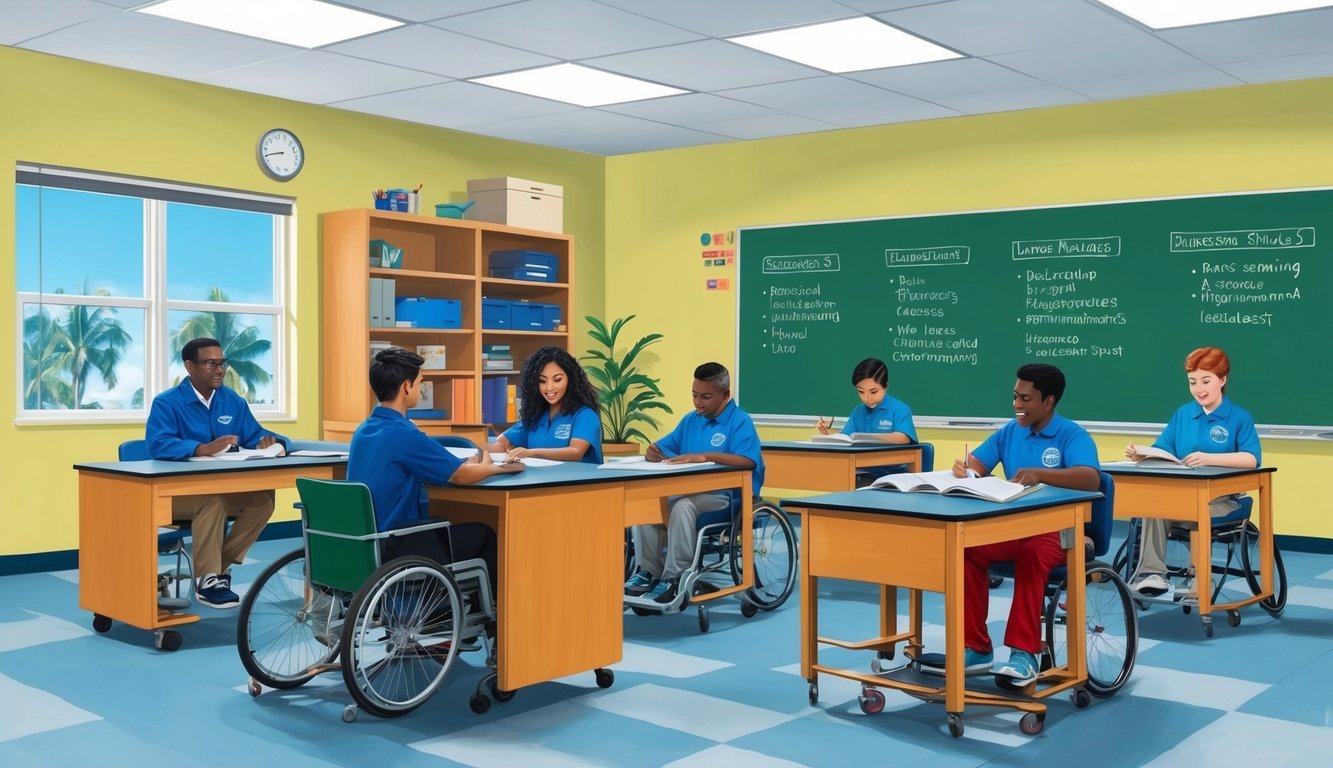Florida offers a variety of options for those interested in pursuing a career in physical therapy.
With its sunny climate and diverse population, it is an attractive location for both students and healthcare professionals.
Accredited physical therapy schools in Florida provide quality education and prepare you for a successful career.
These programs often include hands-on training and a strong curriculum that focuses on the skills needed for effective patient care.
As you navigate through your choices, consider factors such as admissions requirements, specializations, and potential career paths.
By understanding the landscape of physical therapy education in Florida, you can make informed decisions about your future.
Key Takeaways
- Florida has many accredited physical therapy schools offering various programs.
- Quality education combines both theoretical learning and practical experience.
- Understanding admission processes and career opportunities will aid in your decision-making.
Overview of Physical Therapy Education in Florida
Physical therapy education in Florida offers a comprehensive training pathway through accredited Doctor of Physical Therapy (DPT) programs.
These programs prepare you to become skilled professionals capable of providing quality rehabilitation services.
Understanding Physical Therapy
Physical therapy focuses on helping patients restore movement and manage pain after injuries, surgeries, or chronic conditions.
In Florida, physical therapists are highly trained to analyze and treat various musculoskeletal issues.
As a student, you will learn about anatomy, physiology, and specific techniques used in patient care.
Programs include both classroom instruction and hands-on clinical experiences to develop your skills.
Notable institutions like the University of South Florida and the University of Florida offer robust training in this field.
Examining the DPT Program Structure
The DPT program in Florida usually spans three years of coursework and clinical practice.
Each program includes essential subjects such as therapeutic exercises, patient evaluation, and rehabilitation techniques.
Here’s a brief overview of program components:
| Component | Description |
|---|---|
| Classroom Instruction | Courses on anatomy, biomechanics, and patient care strategies. |
| Clinical Practicum | Hands-on training in various healthcare settings under supervision. |
| Research Component | Opportunities to engage in research and evidence-based practice. |
Schools like FIU prepare students with a curriculum guided by the American Physical Therapy Association (APTA).
This ensures that you graduate with the knowledge and practical skills needed to succeed in your career.
Accredited Physical Therapy Schools and Programs

When considering physical therapy education in Florida, several accredited programs stand out.
These institutions ensure that students receive quality training in the field.
Here are key details on notable programs.
University of South Florida (USF)
The University of South Florida (USF) offers a Doctor of Physical Therapy (DPT) program through its School of Physical Therapy & Rehabilitation Sciences.
This program is fully accredited by the Commission on Accreditation in Physical Therapy Education (CAPTE).
USF’s DPT program focuses on preparing students for clinical practice.
The curriculum includes hands-on labs, evidence-based practice, and community engagement.
Located in Tampa, this program also emphasizes research and clinical experiences.
Students can expect to complete the program in three years, covering a total of 98 credits.
The hands-on training is essential for building the skills you will need as a physical therapist.
University of Central Florida (UCF)
The University of Central Florida (UCF) also offers a well-respected Doctor of Physical Therapy program.
This program is also accredited by CAPTE, ensuring it meets high educational standards.
UCF’s program features a hybrid learning model that combines online coursework with traditional classroom settings.
Located in Orlando, you will benefit from diverse clinical practice opportunities throughout the state.
The curriculum emphasizes fundamental physical therapy skills and prepares students for the National Physical Therapy Exam (NPTE).
Graduates from UCF are well-equipped to enter the workforce and serve patients effectively.
Florida International University (FIU)
Florida International University (FIU) offers a comprehensive Doctor of Physical Therapy program through the Nicole Wertheim College of Nursing & Health Sciences.
The program is accredited by CAPTE and includes a strong emphasis on practical training.
FIU’s DPT program is structured over nine semesters, allowing students to gain both academic knowledge and hands-on experience.
Located in Miami, FIU provides students with access to a diverse patient population.
Students learn in state-of-the-art facilities and have opportunities for research and community service.
The emphasis on clinical practice ensures you will be ready for your career immediately after graduation.
Other Notable Institutions
In addition to USF, UCF, and FIU, other institutions in Florida also offer accredited physical therapy programs.
Programs can be found at schools such as the University of St. Augustine for Health Sciences and Nova Southeastern University.
These universities provide various specializations and opportunities for education.
Ensure you research each institution’s accreditation status with CAPTE and program specifics to find the best fit for your career goals.
Admissions and Prerequisites
When applying to physical therapy schools in Florida, it’s important to understand the specifics of admission requirements and what you need to prepare.
This includes standardized test scores, observation hours, and letters of recommendation.
Admission Requirements and Process
To gain entry into a Doctor of Physical Therapy (DPT) program, you must meet several requirements.
This often includes holding a bachelor’s degree from an accredited institution and completing prerequisite courses, such as biology, chemistry, and anatomy.
You will also need to use the Physical Therapist Centralized Application Service (PTCAS), which streamlines the application process for many programs.
The application typically requires:
- GRE scores (if applicable)
- At least 50 hours of clinical observation under a licensed physical therapist
- Two to three letters of recommendation, ideally from professors or professionals in the healthcare field
Make sure to check individual program sites for specific details.
Standardized Tests and Additional Requirements
Many physical therapy schools have standardized test requirements.
The GRE (Graduate Record Examination) is commonly required, though some programs may waive this for strong applicants.
Check your chosen schools’ specific GRE score requirements.
International students must often submit TOEFL (Test of English as a Foreign Language) scores to demonstrate English proficiency.
Additionally, you should be prepared to provide documentation of your observation hours.
Having a diverse range of experience in different settings is beneficial.
Being aware of these requirements will help you stay organized in your application process.
Curriculum and Specializations

Physical therapy programs in Florida provide a comprehensive education that combines core courses with opportunities for specialized studies.
The curriculum emphasizes the importance of clinical education and research, ensuring you gain the skills needed for effective patient care.
Core Courses and Clinical Education
Core courses are fundamental to your training as a physical therapist.
Typically, you will engage in subjects like anatomy, kinesiology, and biomechanics.
These courses form the foundation of your understanding of the human body and its movements.
Clinical education is a key component of most programs.
You will participate in clinical rotations, allowing you to apply your classroom knowledge in real-world settings.
This hands-on experience is critical for developing your skills in patient assessment and treatment planning.
Many programs also incorporate movement science and exercise physiology into their core curriculum, preparing you for diverse clinical challenges.
Research and Interprofessional Education
Research is essential in the field of physical therapy.
Programs often require you to complete a research project, helping you develop critical thinking and analytical skills.
You may explore topics related to neuroscience or exercise physiology, which can enhance your understanding of patient care.
Interprofessional education is also emphasized.
You will collaborate with students from other health disciplines, such as nursing and occupational therapy.
This approach fosters teamwork and communication skills that are vital in healthcare settings.
By learning to work alongside various professionals, you prepare for the collaborative nature of modern medical practice.
Advanced Studies in Physical Therapy Fields
Once you complete the foundational courses, many schools offer advanced studies in specialized areas.
These can include orthopedics, pediatrics, or geriatrics, allowing you to tailor your education to your interests.
Advanced studies often involve in-depth coursework and additional clinical experiences.
You might study specialized treatments or interventions that address unique patient needs.
Programs also encourage continuing education, helping you stay current with new developments in physical therapy practice.
This dedication to lifelong learning is crucial in providing the best care to your patients.
Career Paths and Licensing
To work as a physical therapist in Florida, you must follow specific steps for licensing and gain hands-on experience through clinical education.
Understanding these key aspects will help you navigate your career path effectively.
Becoming a Licensed Physical Therapist in Florida
To become a licensed physical therapist in Florida, you must first complete a Doctor of Physical Therapy (DPT) program from an accredited institution.
After graduation, you need to pass the National Physical Therapy Examination (NPTE).
Once you have passed the NPTE, you will apply for licensure through the Florida Board of Physical Therapy.
This process includes submitting proof of your education, passing examination scores, and paying the required fees.
Upon gaining your license, you can work in various healthcare settings such as hospitals, private practices, outpatient centers, and skilled nursing facilities.
For those interested in treating veterans, opportunities also exist within Veterans Affairs facilities.
Clinical Education Experiences and Internships
Clinical education experiences are a vital part of your training.
Many DPT programs incorporate internship opportunities that allow you to gain practical experience while still in school.
These experiences often take place in diverse settings, including hospitals, outpatient centers, and skilled nursing facilities.
Internships help you develop critical skills in patient care, such as assessment, treatment planning, and hands-on therapy techniques.
Throughout your internship, you will work closely with licensed physical therapists who will supervise and mentor you.
This not only builds your confidence but also prepares you for the real-world challenges you will face in your career.
Engaging in these experiences gives you a competitive edge in the job market.
Professional Development and Continuing Education

Engaging in professional development and continuing education is essential for your growth as a physical therapist.
It allows you to refine your skills, stay current with advancements in the field, and improve patient care through evidence-based methods.
Building Research and Management Skills
To excel in physical therapy, strong research skills are key.
Understanding how to analyze studies and apply findings ensures you provide evidence-based care.
By participating in continuing education courses, you enhance your critical thinking abilities, which are crucial for effective decision-making in your practice.
Management skills are equally important.
As a physical therapist, you may take on leadership roles, requiring you to oversee teams and manage resources.
Courses offered by organizations like the American Physical Therapy Association (APTA) often focus on these skills, helping you navigate challenges in clinical settings.
Advocacy and Professional Resources
Advocacy is vital for the advancement of the physical therapy profession.
You can join associations, such as the APTA, to connect with resources that support legislative initiatives and promote best practices.
Engaging in advocacy efforts helps ensure that physical therapy remains a vital healthcare service.
Utilizing professional resources helps you stay informed about the latest trends and changes in the field.
Membership in state organizations, like the Florida Physical Therapy Association, connects you with approved continuing education courses.
These courses are tailored to license renewal and skills enhancement, aligning your practice with professional standards.
Frequently Asked Questions

This section addresses common queries regarding physical therapy schools in Florida.
It provides specific details about accreditation, program rankings, duration, affordability, online options, and the structure of 3+3 programs.
What are the accreditation requirements for physical therapy schools in Florida?
In Florida, the Commission on Accreditation in Physical Therapy Education (CAPTE) accredits physical therapy programs.
This ensures that the programs meet national standards for education and training.
Attending an accredited school is crucial for obtaining licensure after graduation.
Which institutions offer the highest-rated Doctor of Physical Therapy (DPT) programs in Florida?
Several institutions in Florida are known for their top-rated DPT programs.
Here are a few:
| Institution | Location |
|---|---|
| University of Florida | Gainesville |
| University of North Florida | Jacksonville |
| Florida International University | Miami |
| Nova Southeastern University | Fort Lauderdale |
These schools have strong reputations based on academic excellence and graduate outcomes.
What is the typical duration of a Doctor of Physical Therapy program in Florida universities?
Most DPT programs in Florida typically take about 3 years to complete.
This includes both coursework and clinical experiences.
Some institutions offer accelerated options, which may shorten the duration.
Are there any affordable physical therapy educational programs available in Florida?
Yes, you can find affordable DPT programs in Florida.
Public universities often have lower tuition rates for in-state residents.
It’s helpful to compare costs across institutions, as financial aid and scholarships may also be available to help manage expenses.
How do online and hybrid DPT programs compare to traditional on-campus programs in Florida?
Online and hybrid DPT programs provide flexibility for students who need it.
While traditional programs offer hands-on learning with immediate feedback, online options may involve virtual simulations and clinical placements.
It’s essential to consider your learning style and personal commitments when choosing a format.
Can you explain the structure of 3+3 DPT programs available in the state of Florida?
The 3+3 DPT program allows students to complete a bachelor’s degree and a Doctor of Physical Therapy degree in a total of six years.
In the first three years, students focus on undergraduate coursework.
Then, they transition into the DPT program for the subsequent three years, which includes clinical education.
This pathway can save time and streamline your education.

